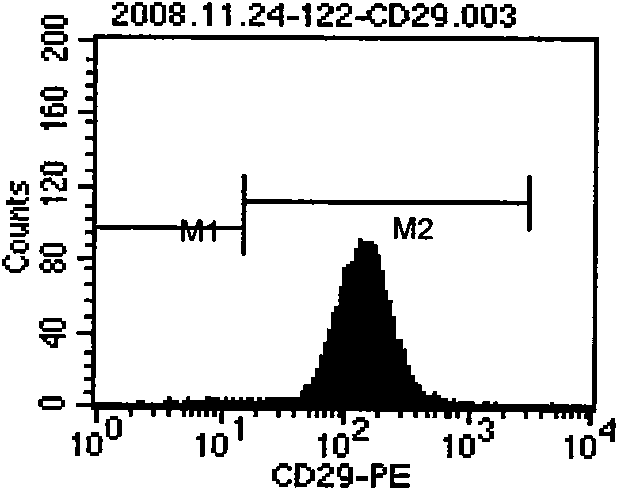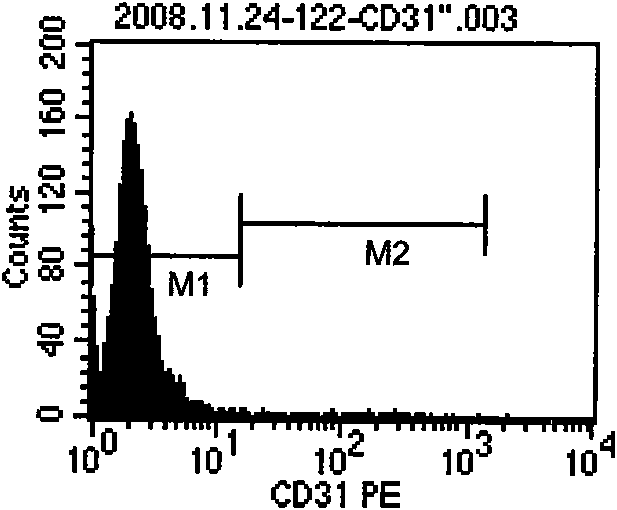Method for obtaining mesenchyma stromal cells from connective tissue
A technology of connective tissue and stromal cells, applied in tissue culture, biochemical equipment and methods, microorganisms, etc., can solve problems such as decreased adherence rate, increased solution viscosity, and reduced centrifugation efficiency, so as to improve homogeneity and promote Effect of degradation and reduction of solution viscosity
- Summary
- Abstract
- Description
- Claims
- Application Information
AI Technical Summary
Problems solved by technology
Method used
Image
Examples
Embodiment 1
[0071] Isolation of umbilical cord connective tissue mesenchymal stem cells
[0072] 1. The environment for the isolation of umbilical cord mesenchymal stem cells: The isolation of stem cells should be strictly controlled in environmental pollution and drastic changes, and it is required to be carried out in a 100-level GMP workshop.
[0073] 2. Supplies needed for umbilical cord separation:
[0074] a) Instrument
[0075] i. Purification workbench
[0076] ii. Digital constant temperature air bath oscillator
[0077] b) Devices
[0078] i.14cm hemostatic forceps (uncoated)
[0079] ii.16cm scissors (uncoated)
[0080] iii.16cm tweezers
[0081] iv. Kidney shaped disc
[0082] v. Electric pipette gun
[0083] c) Glassware and consumables
[0084] i.200ml beaker
[0085] ii. Centrifuge tube
[0086] iii. Syringe
[0087] d) Reagents
[0088] i.Digestive juice
[0089] Preparation scheme: Dissolve 5-7g Nacl in 1000ml triple distilled water; 0.44g Kcl; 0.187g NaH 2...
Embodiment 2
[0117] Isolation and extraction of fat stem cells
[0118] 1. Equipment, Consumables and Reagents
[0119] (1) Instrument
[0120] 1. Purification workbench
[0121] 2.PH meter
[0122] (2) Glassware
[0123] 1.250ml beaker
[0124] 2. Waste tank
[0125] (three) plastic utensils
[0126] 1.50ml syringe
[0127] 2.20ml syringe
[0128] 7. T25 / 75 culture flask
[0129] 8. Pipette
[0130] (4) Other items
[0131] 1. Pipette
[0132] (5) Reagents
[0133] 1. PBS
[0134] 2. Experimental steps
[0135] Take the fat obtained aseptically during liposuction, store it in the separation liquid, and process it within 1-24 hours
[0136] Wash the fat repeatedly with the cleaning solution, resuspend and wash away the red blood cells, and cut up the fat
[0137] Transfer the shredded tissue to a 50ml centrifuge tube, add cleaning solution, centrifuge at 250g for 5min at room temperature, and remove the supernatant
[0138] After resuspension and washing with cleaning solu...
Embodiment 3
[0144] The method for separating the connective tissue mesenchymal stromal cells comprises the following technical steps:
[0145] (1) Take the aseptically obtained connective tissue, store it in the separation solution, and process it within 1-24 hours;
[0146] (2) Wash the tissue repeatedly with the cleaning solution, resuspend and wash away the red blood cells, and cut the tissue into pieces;
[0147] (3) Transfer the shredded tissue to a 50ml centrifuge tube, add cleaning solution, centrifuge at 250g room temperature for 5min, and remove the supernatant;
[0148] (4) After resuspension and washing with cleaning solution, add 18ml of digestion solution and 2ml of catalytic solution, place in an air bath shaker at 37°C, and digest at 200r / min for 1h;
[0149] (5) Use a cotton ball dipped in 75% alcohol to wipe the surface of the centrifuge tube. After the flame of the alcohol lamp briefly burns the centrifuge tube mouth, remove the digestive juice and filter it with a 300-...
PUM
 Login to View More
Login to View More Abstract
Description
Claims
Application Information
 Login to View More
Login to View More - R&D
- Intellectual Property
- Life Sciences
- Materials
- Tech Scout
- Unparalleled Data Quality
- Higher Quality Content
- 60% Fewer Hallucinations
Browse by: Latest US Patents, China's latest patents, Technical Efficacy Thesaurus, Application Domain, Technology Topic, Popular Technical Reports.
© 2025 PatSnap. All rights reserved.Legal|Privacy policy|Modern Slavery Act Transparency Statement|Sitemap|About US| Contact US: help@patsnap.com



